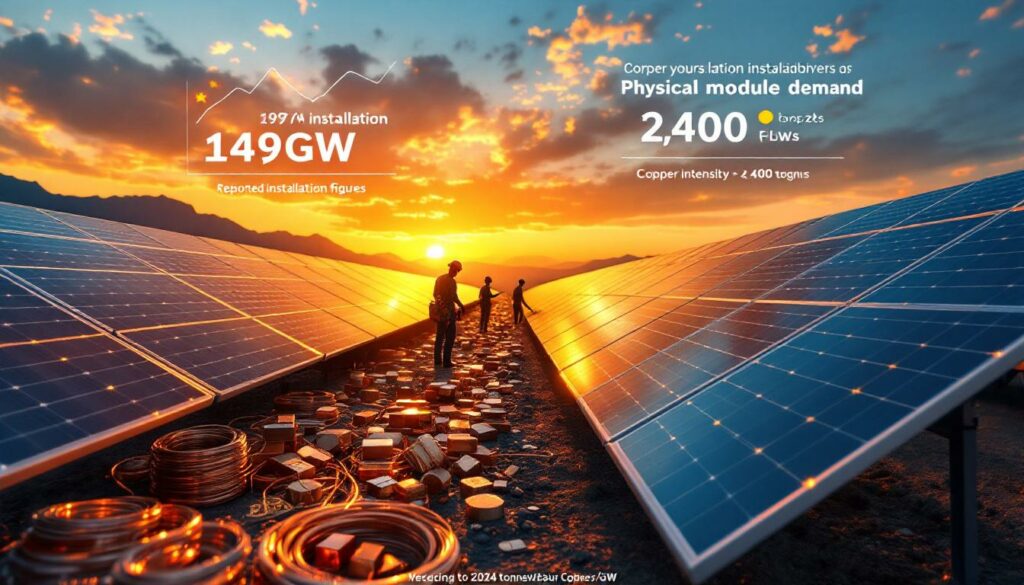What's Behind China's Surprising PV Installation Numbers?
China's photovoltaic (PV) sector has stunned market analysts with extraordinary installation figures from the National Energy Administration (NEA). Between January and May 2025, China reported a staggering 197.85 GW of new PV installations—representing a 150% year-over-year increase. This dramatic surge has led many market observers to assume how much copper demand can this year's misleading pv installations actually drive would experience corresponding growth.
However, when we analyze the actual module production and consumption data, a more nuanced picture emerges. China produced 237 GW of PV modules from January to May 2025, with net exports reaching 109.04 GW during this period. Meanwhile, module inventory decreased significantly by 26.25 GW (from 51.01 GW to 24.76 GW).
Using the formula of production minus exports plus inventory reduction, we can calculate that actual domestic module demand was approximately 154.21 GW—creating a discrepancy of roughly 40 GW between reported installations and physical module demand.
Understanding the Installation vs. Demand Gap
This gap between reported installations (197.85 GW) and calculated demand (154.21 GW) isn't a statistical error but rather stems from China's regulatory environment. The discrepancy likely results from pre-registered projects under the "531 Policy"—a regulatory framework that encourages developers to register projects early while actual construction occurs later.
Industry experts note that these pre-registered projects will physically materialize in the second half of 2025, and importantly, will not be double-counted in future installation statistics. This creates a front-loading effect in the official data that doesn't immediately translate to copper price insights.
The pre-registration phenomenon is particularly notable in distributed solar projects, which face additional permitting requirements and longer implementation timelines compared to utility-scale installations. This regulatory-induced statistical anomaly has created significant confusion among commodity analysts attempting to forecast material demand.
How Does Copper Intensity in PV Systems Actually Work?
Copper serves as a critical material in photovoltaic systems, but the relationship between installed capacity and copper consumption is more complex than a simple multiplier.
Copper Usage in Modern PV Systems
In today's solar installations, copper fulfills several essential functions:
- Electrical wiring and interconnections: Copper conductors transfer electricity from panels to inverters and the grid
- Inverter components: Internal transformers and circuit boards contain significant copper content
- Transformers and substations: Medium and high-voltage equipment for grid connection
- Grounding systems: Essential safety infrastructure throughout the installation
- Energy storage integration: Battery connections and associated wiring when storage is included
A typical utility-scale solar farm requires copper not just in the visible panels and frames, but throughout the balance of system (BOS) components. The distribution between these applications has shifted over time, with inverter technology improvements and optimized system designs changing the overall material footprint.
Technological Evolution Affecting Copper Intensity
The relationship between PV capacity and copper consumption isn't static—it continues to evolve with technological advancements:
- PV conversion efficiency improvements have reduced material requirements per megawatt
- Copper intensity has declined from 2,500 tonnes/GW in 2024 to 2,400 tonnes/GW in 2025
- Advanced inverter designs with higher power density require less copper per unit of capacity
- Optimization of DC:AC ratios has reduced copper requirements in newer installations
- Higher voltage systems (1500V DC becoming standard) allow for reduced conductor sizing
This 4% year-over-year efficiency improvement represents significant progress in material optimization, even as the overall sector continues to expand. Systems integrators have increasingly focused on reducing metal intensity as a key cost reduction strategy, particularly as copper prices have remained at historically elevated levels.
"The evolving copper intensity in solar installations reflects broader technological maturation in the renewable energy sector. While early PV systems prioritized reliability through material redundancy, modern designs achieve the same performance with increasingly optimized resource utilization." — SMM Metals Analysis Team
What Are the Real Copper Demand Projections for 2025?
When accounting for both installation trends and changing copper intensity, a clearer picture of actual copper demand emerges. The projections must consider both the statistical anomalies in reported installations and the technological evolution affecting material requirements.
First Half 2025 Copper Demand from PV
For the first half of 2025, we can now calculate more accurate copper demand figures:
- Actual installations: 165 GW (compared to 102.5 GW in H1 2024)
- Copper intensity: 2,400 tonnes/GW
- Estimated copper demand: 396,000 tonnes
- Year-over-year increase: 54.57% (compared to 256,200 tonnes in H1 2024)
This significant growth reflects both increased installation volumes and the timing effects of the pre-registration policy. The first-half surge represents projects that had been planned throughout the preceding year finally reaching completion.
Second Half 2025 Projections
For the second half of 2025, the outlook shifts considerably:
- Projected installations: 132.1 GW (compared to 174 GW in H2 2024)
- Estimated copper demand: 317,000 tonnes
- Year-over-year decrease: 27.11% (compared to 435,000 tonnes in H2 2024)
This projected decline stems from the front-loading effect of installations into the first half of the year, rather than any fundamental weakness in the sector. The installation pattern represents a temporal shift rather than a reduction in overall annual capacity additions.
Full-Year 2025 Outlook
When combining both halves of the year, the full 2025 outlook shows:
| Period | Installations | Copper Demand | YoY Change |
|---|---|---|---|
| H1 2024 | 102.5 GW | 256,200 tonnes | – |
| H1 2025 | 165 GW | 396,000 tonnes | +54.57% |
| H2 2024 | 174 GW | 435,000 tonnes | – |
| H2 2025 | 132.1 GW | 317,000 tonnes | -27.11% |
| Full 2024 | 276.5 GW | 675,000 tonnes | – |
| Full 2025 | 297.1 GW | 713,000 tonnes | +5.6% |
This modest 5.6% year-over-year increase in copper demand (representing approximately 38,000 additional tonnes) stands in stark contrast to the headline 150% growth in installations reported for early 2025. The discrepancy highlights the importance of understanding both the timing of physical deployments and the evolving material efficiency of modern PV systems.
Why Is There Such a Disconnect Between Installation Figures and Copper Demand?
The substantial gap between reported installation growth rates and actual copper demand increases stems from multiple factors that affect both the statistical reporting and physical material requirements.
Regulatory and Market Factors
Several key regulatory and market dynamics contribute to the disconnect:
- Pre-registration policies create statistical anomalies that front-load reported installations
- Project approval vs. actual construction timelines often span multiple reporting periods
- Inventory management throughout the supply chain affects when materials are consumed
- Component import/export timing often differs from final installation documentation
- Provincial vs. national reporting discrepancies in China's multi-layered regulatory framework
The "531 Policy" in particular has incentivized developers to register projects early to secure favorable tariff rates, creating a situation where official installation statistics precede actual physical deployment by several months.
Material Efficiency Improvements
Simultaneous with these regulatory factors, ongoing technical evolution continues to reduce copper requirements:
- Higher efficiency PV modules requiring less copper per watt of capacity
- Optimized system designs reducing overall metal intensity through better engineering
- Alternative materials substituting for copper in certain applications (such as aluminum in some cabling)
- Advanced power electronics reducing copper content in inverters and transformers
- Higher voltage architectures enabling smaller conductor sizes throughout the system
These efficiency improvements have consistently reduced copper intensity by approximately 3-5% annually over recent years, with 2025's reduction to 2,400 tonnes/GW representing the continuation of this trend.
The combination of these regulatory timing effects and material efficiency improvements explains why a headline 150% increase in reported installations translates to just a 5.6% increase in annual copper demand—a critical distinction for metals market participants.
How Does This Impact the Broader Copper Market?
To properly contextualize the PV sector's impact on copper markets, we must consider its relative size and influence within global copper demand patterns.
Contextualizing PV Within Total Copper Demand
The photovoltaic sector represents only a modest portion of overall copper consumption:
- PV sector accounts for approximately 3-5% of global copper consumption
- Annual copper market exceeds 25 million tonnes globally
- 2025's projected 38,000 tonne increase in PV-related copper demand represents just 0.15% of the global market
- By comparison, electric vehicles are expected to consume over 1.1 million tonnes of copper in 2025
This relatively small market share means that even significant percentage changes in PV-related demand have limited impact on overall copper market fundamentals. While renewable energy remains a growth driver for copper, other sectors like electrification, infrastructure, and consumer electronics collectively exert far greater influence on market dynamics.
Balancing Supply and Demand Factors
The modest increase in PV-related copper demand occurs against a backdrop of broader market dynamics:
- Mining production constraints including ore grade declines at major producers
- Competing demand from electric vehicles, grid infrastructure, and data centers
- Recycling contributions increasingly offsetting primary production requirements
- Regional supply challenges including political uncertainty in key copper-producing regions
- Inventory levels throughout the value chain affecting price responsiveness
Recent disruptions at major mines like Cobre Panama and ongoing labor negotiations in Chile have had significantly more impact on copper markets than fluctuations in PV installations. While renewable energy represents a long-term growth driver for copper demand, short-term market movements remain primarily influenced by traditional supply-side factors.
What Should Investors and Industry Participants Watch For?
Given the complex relationship between reported PV installations and actual copper consumption, market participants should focus on specific indicators that provide more reliable signals about material demand trends.
Key Indicators to Monitor
Several metrics offer clearer insights than headline installation numbers:
- Actual module shipments vs. reported installations to identify timing discrepancies
- Inventory levels throughout the supply chain as indicators of physical demand
- Policy changes affecting installation reporting in key markets like China and Europe
- Technological developments impacting copper intensity in next-generation systems
- Regional installation patterns that may have different copper intensity profiles
- Component manufacturer order books as leading indicators of physical deployment
By tracking these indicators collectively rather than focusing solely on headline installation figures, market participants can develop more accurate forecasts of actual copper demand from the PV sector.
Long-Term Outlook Considerations
Beyond short-term fluctuations, several structural factors will shape copper demand from PV in coming years:
- Sustained growth trajectory for renewable energy as global energy transition impact accelerates
- Material efficiency improvements vs. volume growth determining net copper demand
- Regional installation patterns with varying copper intensity based on system designs
- Integration with energy storage potentially increasing copper requirements
- Recycling contributions from decommissioned solar farms entering the supply chain
Industry forecasts suggest global PV installations will continue growing at 8-12% annually through 2030, but copper intensity may continue declining at 3-5% per year. The net effect will likely be continued modest growth in absolute copper demand from the sector, but at rates significantly below headline capacity addition statistics.
FAQ: PV Installations and Copper Demand
Why don't PV installation figures directly correlate with copper demand?
Installation statistics can be influenced by regulatory reporting requirements and pre-registration policies, while actual copper consumption depends on physical module deployment, system designs, and technological specifications. The timing gap between registration and physical installation can be several months, creating mismatches between reported figures and material consumption.
How much has copper intensity in PV systems changed over time?
Copper intensity has decreased from approximately 2,500 tonnes/GW in 2024 to 2,400 tonnes/GW in 2025, representing a 4% efficiency improvement in just one year. This continues a multi-year trend of material optimization driven by engineering improvements and cost reduction initiatives. A decade ago, copper intensity exceeded 3,000 tonnes/GW, highlighting the significant efficiency gains achieved.
Will copper demand from PV continue growing in future years?
While overall PV installations are projected to grow at 8-12% annually through 2030, the rate of copper demand increase will be moderated by continued efficiency improvements (3-5% annually) and potential material substitutions. The result will likely be net positive but modest growth in absolute copper demand from the sector—far below the headline installation growth rates that often make news.
How does PV-related copper demand compare to other renewable energy sectors?
PV typically requires less copper per megawatt than wind energy (approximately 2,400 tonnes/GW vs. 3,600 tonnes/GW for onshore wind) but more than traditional fossil fuel generation (approximately 1,000-1,500 tonnes/GW). The distributed nature of PV also creates unique copper demand patterns compared to centralized generation, with a higher proportion going to low-voltage wiring and interconnections rather than transmission infrastructure.
What technological developments might affect future copper intensity in PV?
Several emerging technologies could further reduce copper requirements in future PV systems:
- Higher-efficiency modules requiring less supporting infrastructure per unit of capacity
- Advanced power electronics using gallium nitride or silicon carbide instead of traditional components
- Aluminum substitution in larger conductor applications where space constraints allow
- Integrated panel designs that reduce interconnection requirements
- Higher system voltages enabling smaller conductor sizing throughout installations
Understanding these efficiency trends is crucial for accurate forecasting of how much copper demand can this year's misleading pv installations actually drive. Additionally, advancements in mining industry innovation and gold and copper exploration will determine whether supply can keep pace with demand, while mining decarbonisation benefits could further influence the sector's evolution in coming years.
Further Exploration:
Readers interested in learning more about copper demand in renewable energy sectors can also explore related educational content from Shanghai Metal Market and BHP's insightful analysis on the metal's future in the renewable energy transition.
Ready to Capitalise on the Next Major Mineral Discovery?
Uncover significant investment opportunities ahead of the market with real-time alerts on ASX mineral discoveries through Discovery Alert's proprietary Discovery IQ model. Visit our discoveries page to explore how historic discoveries have generated substantial returns and begin your 30-day free trial today.




